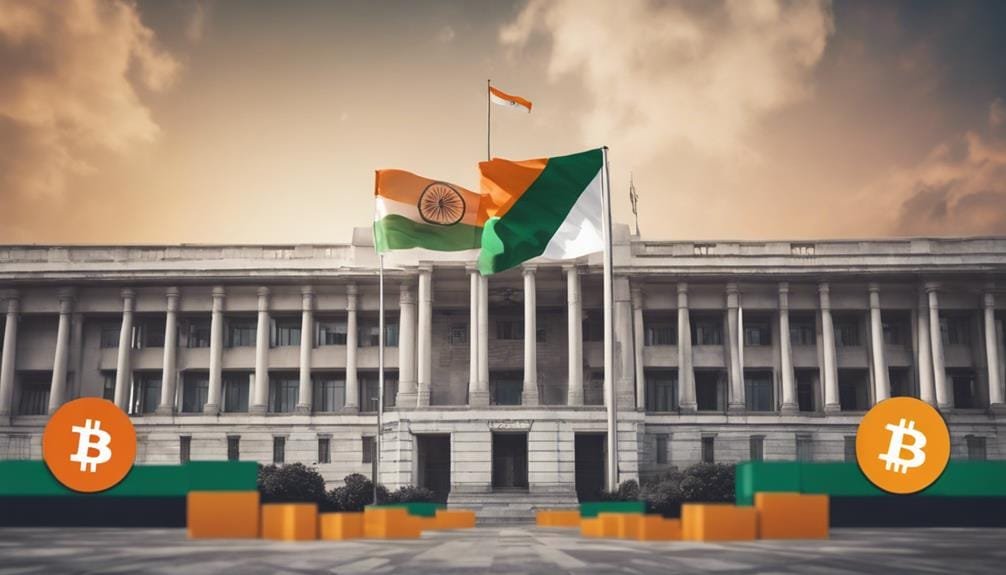The Indian government is developing cryptocurrency through the Digital Rupee, a Central Bank Digital Currency (CBDC) managed by the Reserve Bank of India (RBI). This initiative aims to regulate the cryptocurrency market and provide secure, efficient digital transactions. Unlike private cryptocurrencies, the Digital Rupee emphasizes government control and stability, promoting financial inclusion and accessibility. It operates under strict regulatory guidelines, including a 30% taxation on crypto earnings. While the Digital Rupee offers significant potential benefits, challenges such as technological integration and public acceptance persist. Exploring these aspects can yield further insights into its future implications for India.
Table of Contents
Brief Overview of Indian Government Cryptocurrency
- The Indian government introduced the Digital Rupee as a Central Bank Digital Currency (CBDC) to regulate the cryptocurrency market effectively.
- The Digital Rupee emphasizes government control and stability, contrasting with the volatility seen in private cryptocurrencies.
- The Reserve Bank of India (RBI) advocates for the Digital Rupee to enhance financial stability while opposing private cryptocurrencies due to their risks.
- A 30% tax is imposed on cryptocurrency earnings, aiming for transparency and investor protection amid ongoing regulatory discussions.
- Public acceptance and trust in the Digital Rupee are essential for its success, requiring efforts to educate users about its benefits.
What is Indian Government Cryptocurrency?
The Indian Government Cryptocurrency, known as the Digital Rupee, is a type of Central Bank Digital Currency (CBDC) that’s created and backed by the government.
Unlike private cryptocurrencies like Bitcoin, which operate in a decentralized manner, the Digital Rupee is fully controlled by the Indian government, ensuring regulatory oversight and stability.
This initiative reflects the government’s intent to regulate the cryptocurrency market effectively, as discussed in relation to the impact of the crypto bill.
This distinction highlights the government’s intention to provide a secure and efficient means of digital transactions while maintaining public trust in the financial system.
How Does It Differ from Private Cryptocurrencies?
When comparing Indian Government cryptocurrency, often referred to as a Central Bank Digital Currency (CBDC), to private cryptocurrencies like Bitcoin and Ethereum, several key differences emerge.
The Indian Government cryptocurrency, or digital rupee, is regulated by the Reserve Bank of India, ensuring a stable and secure framework. In contrast, private cryptocurrencies operate in a decentralized manner, often lacking oversight, which can lead to increased volatility and risk.
The government’s proposed ban on private cryptocurrencies highlights concerns about issues like money laundering and tax evasion, further emphasizing the need for regulation.
One of the most significant differences between CBDC and private crypto lies in their purpose. The digital rupee aims to provide a safe and efficient means of transaction, while private cryptocurrencies often focus on speculative investment.
Additionally, the Indian government’s approach to regulation, through the Cryptocurrency and Regulation of Official Digital Currency Bill, 2021, introduces a structured environment for crypto trading, imposing a 30% tax on earnings to promote transparency and security.
RBI’s Role in Cryptocurrency Development
The Reserve Bank of India (RBI) plays an essential role in shaping cryptocurrency development in India, especially through its opposition to private cryptocurrencies.
While cryptocurrency is recognized as an asset, the RBI’s initiatives emphasize the need for regulation to mitigate risks associated with cryptocurrency risks.
By promoting the Digital Rupee initiative, the RBI aims to establish a reliable digital currency that enhances financial stability.
Understanding the RBI’s stance on private cryptocurrencies will clarify its regulatory approach and support for the broader cryptocurrency landscape.
Why Does RBI Oppose Private Cryptocurrencies?
A significant concern for the Reserve Bank of India (RBI) regarding private cryptocurrencies centers on their inherent volatility and associated financial risks. The RBI’s opposition to crypto stems from several private cryptocurrency concerns that could jeopardize the financial stability of investors.
Here are key reasons why the RBI maintains a cautious stance:
- Volatility: Private cryptocurrencies like Bitcoin often experience dramatic price swings, making them unreliable as a stable store of value.
- Financial Risks: High volatility leads to significant financial risks for investors, especially those who may lack experience in trading.
- Illegal Activities: The anonymity associated with private cryptocurrencies can facilitate illicit activities, such as money laundering and fraud.
- Lack of Regulation: Without proper oversight, there’s little protection for investors and no recourse in case of fraud or loss.
These factors shape the RBI’s crypto stance, emphasizing the need for robust cryptocurrency regulations in India.
How Does RBI Support Digital Rupee?
Recognizing the potential benefits of a government-backed digital currency, the Reserve Bank of India (RBI) is actively supporting the development of the Digital Rupee. The RBI’s efforts focus on creating a secure and efficient framework for the Digital Rupee, ensuring it meets the needs of users while safeguarding their interests.
To illustrate the RBI’s support, consider the following key initiatives:
| Initiative | Description |
|---|---|
| Technological Infrastructure | Development of robust systems for secure transactions. |
| Pilot Programs | Testing the Digital Rupee in controlled environments to assess functionality. |
| Regulatory Framework | Establishing guidelines that promote safety and trust in the Digital Rupee. |
Through these initiatives, the RBI aims to bolster confidence in the Digital Rupee, positioning it as a cornerstone of the Indian Government Cryptocurrency strategy. The RBI’s support for the Digital Rupee is essential in creating a legal framework digital rupee that not only encourages innovation but also prioritizes consumer protection and market stability. By fostering a secure environment, the RBI contributes greatly to the overall success of Digital Rupee development.
How Does Indian Government Cryptocurrency Differ from Private Cryptocurrencies?

When comparing Indian government cryptocurrency, specifically the Digital Rupee, with private cryptocurrencies like Bitcoin, significant differences emerge regarding control and stability. The Digital Rupee operates under the auspices of the Reserve Bank of India (RBI), ensuring that it has legal backing and is centrally controlled. In contrast, private cryptocurrencies are often decentralized and lack such regulatory oversight, which can lead to volatility and risk.
Here are four key differences you should consider:
- Control: The Digital Rupee is managed by the RBI, providing a stable and secure framework. Private cryptocurrencies operate independently, meaning there’s no central authority to regulate them.
- Stability: Government cryptocurrencies like the Digital Rupee aim to maintain value and stability, while private cryptocurrencies like Bitcoin are known for their price fluctuations, making them less dependable for safe investments.
- Legal Backing: The Digital Rupee is recognized as official currency, giving it legitimacy in financial transactions. Private cryptocurrencies often exist in a legal gray area, leaving users exposed to potential regulatory changes.
- Purpose: The Digital Rupee aims to improve financial inclusion and efficiency in transactions. Private cryptocurrencies often focus on speculative investment opportunities, lacking the same societal goals.
Understanding these Indian cryptocurrency differences helps highlight why the Digital Rupee could be a safer option compared to private cryptocurrencies like Bitcoin.
In traversing the evolving landscape of RBI and cryptocurrency, prioritizing security and stability is essential.
Timeline of Indian Government’s Stance on Cryptocurrency
The timeline of the Indian government’s stance on cryptocurrency reveals a journey marked by initial regulatory actions and significant Supreme Court involvement.
You’ll see how early concerns led to bans, only for the landscape to shift dramatically with recent developments, including the introduction of the Digital Rupee.
Understanding this progression helps you grasp the complexities of cryptocurrency regulations in India and the government’s current approach.
Initial Regulatory Actions
Maneuvering the complex landscape of cryptocurrency, the Indian government has taken several initial steps towards regulation that set the stage for future developments.
Understanding these actions is essential for anyone interested in the safety and legitimacy of crypto investments. Here’s a brief overview of the initial regulatory actions:
- Proposed Crypto Ban: The government considered a complete ban on private cryptocurrencies, reflecting concerns over security and financial stability.
- Drafting Early Crypto Laws: Initial Crypto Regulations in India included plans for a regulatory framework designed to monitor and control crypto activities effectively.
- RBI’s Role: The Reserve Bank of India (RBI) began exploring a digital rupee, highlighting its intent to maintain control over the currency landscape while promoting a safe investment environment.
- Taxation Policies: They introduced a taxation framework, indicating that earnings from crypto trades would be taxed at 30%, signaling a move towards acceptance rather than outright prohibition.
These Early Crypto Laws India illustrate the government’s cautious yet progressive approach, aiming to balance innovation with necessary safeguards in the evolving domain of crypto regulation in India.
Supreme Court Involvement
As the Indian government laid the groundwork for cryptocurrency regulation, the Supreme Court played a pivotal role in shaping the legal landscape. One of the most significant moments was the landmark judgment that lifted the RBI Ban on cryptocurrency trading in India.
In March 2020, the Supreme Court ruled that the Reserve Bank of India (RBI) couldn’t impose restrictions on crypto transactions, which marked a turning point in the crypto law timeline in India. This decision opened the doors for crypto enthusiasts and investors, allowing for the development of a more robust market.
The ruling emphasized the importance of innovation while also highlighting the need for safety in crypto trading. The Supreme Court’s involvement signaled a commitment to ensuring that regulations would protect investors without stifling development.
However, this also brought to light various risks associated with digital rupees and cryptocurrencies, prompting ongoing discussions about how to balance regulation and freedom in the digital space. The Supreme Court’s stance has certainly shaped the future of RBI cryptocurrency development and continues to influence the evolving nature of India’s approach to digital assets.
Recent Developments
Recent developments in India’s cryptocurrency landscape have been marked by significant milestones, particularly the launch of the Digital Rupee. This move represents a pivotal shift in how the government approaches digital currencies, aiming to balance innovation and security.
However, there are digital rupee challenges that need addressing, especially regarding its adoption and integration with existing financial systems.
Here are some key points on recent crypto developments in India:
- Digital Rupee Launch: The Reserve Bank of India officially introduced the Digital Rupee, aiming to enhance transaction efficiency.
- Current Crypto Regulation India: The government is working on a thorough regulatory framework to guarantee safe trading practices.
- Private Cryptocurrency vs Government Cryptocurrency: Ongoing discussions highlight the differences, with government cryptocurrencies focusing on stability and security.
- Benefits of Digital Rupee: It promises lower transaction costs, better tracking, and reduced risk of fraud.
As these developments unfold, it’s essential for you to stay informed about the implications of these changes on the cryptocurrency market and your investments.
Challenges Faced in Implementing Indian Government Cryptocurrency

When it comes to implementing the Digital Rupee, the Indian government faces several significant challenges.
Technological barriers hinder efficient integration, while security concerns about digital currencies raise alarms among potential users.
Additionally, public acceptance remains a critical issue, as many are still skeptical about embracing a government-backed cryptocurrency.
Technological Barriers
Implementing the Digital Rupee involves maneuvering significant technological barriers that could hinder its successful deployment. You might find it interesting to know that overcoming these Digital Rupee Technology Challenges is essential for ensuring a smooth shift to a digital economy.
Here are four key areas that require attention:
- Scalability: The system must handle a high volume of transactions without delays, which can be a challenge with existing infrastructure.
- Integration: It’s important to seamlessly integrate the Digital Rupee with current banking and payment systems, ensuring compatibility and ease of use.
- Data Security: As digital payments in India increase, safeguarding sensitive information from cyber threats is paramount to maintain trust in the system.
- User Education: Ensuring the public understands how to use the Digital Rupee effectively is crucial to encourage widespread adoption.
Addressing these CBDC Technology Barriers and Indian Government Crypto Tech Issues isn’t just about technology; it’s about building a secure and efficient framework for digital payments in India.
A focus on these aspects will help mitigate risks and enhance digital rupee security, paving the way for a successful implementation.
Security Concerns
As the rollout of the Digital Rupee approaches, security concerns come to the forefront, demanding attention from both the government and the public. You might worry about potential risks linked to CBDC security concerns, especially with the rise of hacking and fraud incidents in the digital space.
The implementation of a government-backed cryptocurrency like the Digital Rupee requires robust security measures to protect users’ personal data and financial assets. The Reserve Bank of India (RBI) must address these significant issues to guarantee Cryptocurrency Security India remains a priority.
You should feel confident that the Digital Rupee can withstand cyber threats and safeguard your information. The government’s efforts to create a secure environment for digital transactions are essential, as any breach could undermine trust and slow adoption.
Regulatory frameworks need to be thorough, encompassing not just the technology behind the Digital Rupee but also strategies to counteract potential attacks. As the government pushes forward, your awareness and understanding of these security measures will play a key role in guaranteeing a safe changeover to this new digital currency.
Ultimately, the goal is to foster a secure ecosystem that encourages innovation while protecting you, the user.
Public Acceptance
Public acceptance of the Digital Rupee poses significant challenges for the Indian government, particularly in convincing citizens to trust a government-backed digital currency. Many people are hesitant about this shift, driven by concerns over security and usability.
Here are some key issues affecting Indian Government Cryptocurrency Acceptance:
- Trust in Government: People may worry about whether the government can manage and secure a digital currency effectively.
- Understanding of CBDC: A lack of awareness about how Central Bank Digital Currencies (CBDCs) function contributes to skepticism and reluctance.
- Technology Barriers: Digital rupee technology may seem complex, making it difficult for individuals less familiar with digital finance to feel comfortable using it.
- Cross-Border Payments: Concerns about how the Digital Rupee will integrate with international systems for cross-border payments could deter users from adopting it.
Taxation and Legal Framework for Indian Government Cryptocurrency
When looking at the Indian Government’s approach to cryptocurrency, you’ll notice a clear legal framework surrounding the Digital Rupee.
The proposed taxation policies, including a hefty 30% tax on earnings, set the stage for how you might interact with this official digital currency compared to private cryptocurrencies.
Understanding these regulations is essential for traversing the evolving landscape of crypto in India.
Taxation Policies on Cryptocurrency
The taxation policies on cryptocurrency in India are becoming increasingly structured, particularly with the introduction of the Cryptocurrency and Regulation of Official Digital Currency Bill, 2021.
This legislation aims to provide clarity on crypto tax India, imposing a 30% tax on earnings from private cryptocurrencies and setting a framework for the upcoming digital rupee. The Reserve Bank of India (RBI) is expected to play an important role in shaping the digital rupee tax policies.
Here are four key points to reflect on regarding cryptocurrency taxation in India:
- 30% Tax Rate: All profits from cryptocurrency trading are subject to a flat 30% tax, making it essential to keep track of your trades for accurate reporting.
- No Deductions: Unlike traditional investments, you can’t deduct expenses related to cryptocurrency trading, which can impact your overall tax liability.
- Reporting Requirements: You must report your cryptocurrency transactions in your income tax returns, ensuring compliance with the law.
- Future of CBDC: The introduction of a Central Bank Digital Currency (CBDC) may lead to distinct digital rupee tax policies, offering a regulated alternative for investors.
Understanding these aspects will help you navigate cryptocurrency taxation in India safely.
Legal Framework for Digital Rupee
India’s legal framework for the Digital Rupee is designed to guarantee both consumer protection and compliance with anti-money laundering laws. As the country moves toward implementing its central bank digital currency (CBDC), the Indian government cryptocurrency timeline reflects a commitment to establish clear regulations.
The Cryptocurrency and Regulation of Official Digital Currency Bill, 2021, serves as a pivotal piece of legislation, outlining the legal measures necessary for the safe trading of cryptocurrencies. This framework aims to create a secure environment where consumers can confidently engage with the Digital Rupee.
It emphasizes transparency in transactions, ensuring that users are safeguarded against fraud and other risks. Additionally, the bill introduces a tax rate of 30% on earnings, reinforcing the government’s intent to regulate this emerging space effectively.
Moreover, the legal structure incorporates international cooperation, particularly during India’s G-20 presidency, promoting a collaborative approach to cryptocurrency regulation. This balance of innovation and investor protection is essential as the Indian government works to foster a stable market.
Public Reception of Indian Government Cryptocurrency

As you consider the public reception of the Digital Rupee, you’ll notice a mix of support and criticism among investors and the crypto community.
Many investors appreciate the regulatory clarity and potential benefits of a government-backed cryptocurrency, while critics argue that it stifles the innovation and freedom typically associated with decentralized digital currencies.
This split in opinion highlights the ongoing debate about balancing regulation with the evolving landscape of cryptocurrency in India.
Support from Investors
A growing number of investors and financial institutions are expressing optimism about the Digital Rupee, seeing it as a game-changer for the Indian cryptocurrency landscape. This support stems from the Indian government’s proactive approach to creating a regulatory framework that guarantees safety and stability in the market.
As a result, many investors are now looking at the Digital Rupee as a viable option for their portfolios.
Here are a few reasons why investor support for the Digital Rupee is rising:
- Regulatory Clarity: The Cryptocurrency and Regulation of Official Digital Currency Bill aims to provide a structured environment for crypto trading, which enhances investor confidence.
- Taxation Framework: A clear tax rate of 30% on earnings offers predictability for potential returns, making it easier for investors to plan their strategies.
- Global Leadership: India’s push for international cooperation during its G-20 presidency signals a commitment to balanced regulation, which could attract foreign investments.
- Increased Adoption: Financial institutions are recognizing the potential of CBDCs, suggesting a broader acceptance of the Digital Rupee in mainstream finance.
With these factors in play, the Digital Rupee is gaining traction among cautious investors seeking secure opportunities.
Criticism from the Crypto Community
The crypto community voices significant concerns over the Digital Rupee, perceiving it as a potential threat to the existence of private cryptocurrencies. Many in the community worry that a government-backed digital currency could undermine the decentralized nature that attracts users to cryptocurrencies in the first place.
They fear that the Digital Rupee may lead to increased scrutiny and regulation, stifling innovation and limiting opportunities for growth. Critics argue that imposing a hefty 30% tax on earnings from crypto trading could deter investors, creating a less favorable environment for participation.
They believe that this regulatory approach may push users towards unregulated platforms, which could expose them to higher risks. Additionally, there’s anxiety that the Digital Rupee could facilitate government surveillance over transactions, infringing on privacy rights that many value in the crypto space.
As India seeks to establish a thorough regulatory framework, the crypto community calls for a balanced approach. They emphasize the need for regulations that protect investors while allowing room for innovation.
Ultimately, the success of the Digital Rupee depends on how well it can coexist with private cryptocurrencies, addressing these concerns while ensuring safety for all users.
Global Impact of Indian Government Cryptocurrency
The introduction of the Digital Rupee could greatly reshape global trade and investment dynamics, as it provides a new avenue for cross-border payments.
By streamlining transactions and reducing costs, the Digital Rupee may encourage international partnerships and economic collaborations.
As the Indian government promotes this cryptocurrency, its global effect could foster a more interconnected financial landscape.
Influence on Global Trade
Emerging as a notable player in international trade, the Digital Rupee could reshape how transactions are conducted, particularly in developing markets. As the Indian government rolls out this cryptocurrency, it sets the stage for safer and more efficient trade practices across borders.
Here’s how it might influence global trade:
- Lower Transaction Costs: With reduced fees associated with digital currencies, businesses can save money on cross-border transactions.
- Faster Settlement Times: The Digital Rupee could markedly speed up transaction processing, allowing for quicker trade agreements and deliveries.
- Enhanced Transparency: By utilizing blockchain technology, the Digital Rupee can offer a transparent ledger, reducing the risk of fraud and enhancing trust among trading partners.
- Increased Accessibility: This cryptocurrency can help businesses in emerging markets participate in global trade, providing them with easier access to international markets.
Impact on Cross-border Payments
With the introduction of the Digital Rupee, cross-border payments stand to benefit greatly from this innovation. The Indian government cryptocurrency, or CBDC, promises to streamline international transactions, reducing costs and enhancing efficiency. By utilizing a centralized digital currency, you can expect quicker settlements compared to traditional methods, which often involve multiple intermediaries and lengthy processing times.
One of the key advantages of the Digital Rupee in cross-border payments is its potential to lower transaction fees. Conventional international payments can be costly due to currency conversion and bank charges. With the Digital Rupee, these fees may decrease significantly, making it an attractive option for businesses and individuals alike.
Moreover, the Indian government’s commitment to establishing a regulatory framework adds a layer of security for users. As they pursue international collaboration on cryptocurrency regulations, you can feel more assured about the stability and safety of your transactions.
However, it’s vital to stay informed about evolving policies to navigate potential risks. Overall, the Digital Rupee could transform how you engage in international payments, offering both efficiency and peace of mind.
Regulatory Measures on Private Cryptocurrencies in India

When you think about private cryptocurrency regulation in India, you’ll notice the government’s serious stance on potential bans and controls.
The Cryptocurrency and Regulation of Official Digital Currency Bill, 2021, is a key step toward formalizing these measures, aiming to create a safe trading environment while addressing concerns over market stability.
As the Indian government shapes its policies, understanding the balance between innovation and regulation becomes essential for anyone interested in the evolving crypto landscape.
Crypto Ban in India
The Indian government’s stance on private cryptocurrencies is creating ripples of uncertainty among investors and traders alike.
With ongoing discussions about a potential crypto ban in India, many are left wondering what this means for their financial future. The government is actively weighing the pros and cons of regulating private cryptocurrencies, and this has sparked concerns across the market.
Here are some key points to reflect on:
- Investor Protection: The government aims to guarantee that investors are protected from the volatility and risks associated with private cryptocurrencies.
- Tax Implications: The proposed legislation includes a hefty tax rate of 30% on earnings, which could discourage some investors.
- International Collaboration: As India leads global initiatives, there’s a call for a unified approach to cryptocurrency regulation, balancing innovation with safety.
- Market Stability: A potential ban could greatly impact market stability, emphasizing the need for clear and structured regulations.
In this climate of uncertainty, it’s vital for you to stay informed and prepared for any regulatory developments regarding private crypto ban in India.
Steps Toward Regulating Private Cryptocurrencies
Amid the ongoing discussions about a potential crypto ban in India, the government has initiated several important steps toward regulating private cryptocurrencies.
The cornerstone of these efforts is the Cryptocurrency and Regulation of Official Digital Currency Bill, 2021, which seeks to establish a structured environment for crypto trading. This legislation aims to impose a tax rate of 30% on earnings from private cryptocurrencies, creating a framework that provides transparency for investors.
In addition to taxation, the Indian government is focusing on implementing legal requirements for crypto exchanges and service providers. This includes rigorous compliance measures to guarantee that these entities operate within the law, enhancing overall market stability.
The government is also advocating for a collaborative international approach, especially during its G-20 presidency, to address the challenges posed by cryptocurrencies globally.
Steps to Adopt Indian Government Cryptocurrency
To adopt the Indian Government Cryptocurrency, you’ll first need to set up a digital wallet that supports the Digital Rupee.
This wallet will allow you to securely store and manage your digital currency.
Once you have your wallet ready, you can start making transactions, enabling you to engage with the evolving landscape of digital finance in India.
How to Use the Digital Rupee
Using the Digital Rupee is a straightforward process that empowers individuals and businesses to engage in secure cryptocurrency transactions. This official digital currency, backed by the Indian government, provides a reliable option for those looking to navigate the evolving crypto landscape safely.
To begin using the Digital Rupee, follow these steps:
- Acquire Digital Rupee: Start by purchasing the Digital Rupee through authorized channels, ensuring you comply with regulations set forth by the government.
- Understand Transaction Procedures: Familiarize yourself with the transaction protocols, which include how to send and receive funds securely, protecting your assets.
- Utilize Digital Platforms: Access user-friendly platforms that facilitate Digital Rupee transactions, ensuring your data remains secure and private, preventing unauthorized access.
- Stay Informed: Keep up with the latest updates on regulations and tax implications related to Indian Government Cryptocurrency Transactions, as the landscape is continually evolving.
Setting Up Digital Wallets
Setting up a digital wallet is an essential step in adopting the Digital Rupee, allowing you to store and transact with this official currency securely.
To create a Digital Rupee Wallet, start by selecting a trusted financial institution or app that offers CBDC wallet services. Confirm that the platform complies with government regulations, which enhances your safety.
Next, download the app or register on the website. During registration, you’ll need to provide personal information, including your identification and perhaps a phone number for verification.
After completing this step, create a strong password that combines letters, numbers, and symbols to enhance security.
Once registered, enable two-factor authentication (2FA) for an extra layer of protection. This can involve receiving a code via SMS or using an authentication app.
Familiarize yourself with the wallet’s features, as they may differ from traditional crypto wallets used for private cryptocurrencies. The Digital Rupee Wallet is designed for secure transactions within the regulated framework established by the Indian government.
Future of Private Cryptocurrencies Amid Government Initiatives

As the Indian government rolls out initiatives like the Digital Rupee, you might wonder about the future of private cryptocurrencies in India.
Stricter regulations and a significant tax on crypto earnings could shift investor sentiment, potentially affecting the survival of private cryptos.
Understanding how these changes will interact with the rise of government-backed digital currencies is vital for anyone interested in the crypto landscape.
Will Private Cryptos Survive?
The future of private cryptocurrencies in India hangs in a delicate balance between innovation and regulation. As the government pushes for a structured environment with the Cryptocurrency and Regulation of Official Digital Currency Bill, 2021, you might wonder if private cryptos can thrive in this setting.
The government’s initiatives, especially with the Digital Rupee, raise questions about the survival of these alternatives.
Here are four key factors to evaluate:
- Regulatory Clarity: Clear regulations could help legitimize private cryptos, making them safer for investors.
- Tax Implications: A 30% tax on earnings may deter some investors, but it could also encourage a more transparent trading environment.
- Market Demand: If there’s robust demand for private cryptos, they might adapt and find a niche even amid regulations.
- Global Collaboration: As India leads discussions on international crypto regulations, a supportive global framework may foster the growth of private cryptos.
While the landscape is shifting, the potential for private cryptocurrencies to coexist with government-backed options remains.
Your awareness of these dynamics could help you navigate this evolving market.
Investor Sentiment on Private Cryptos
Investor sentiment regarding private cryptocurrencies in India is evolving, especially in light of government initiatives like the Digital Rupee. Many crypto investors are reassessing their positions as the Indian government moves towards a regulatory framework with the Cryptocurrency and Regulation of Official Digital Currency Bill, 2021.
This legislation not only introduces a substantial tax rate of 30% on earnings but also signals a shift towards a controlled environment for crypto trading.
As the government emphasizes the Digital Rupee, some investors express concerns about the viability of private cryptocurrencies. They worry that the official digital currency may overshadow the private sector, potentially reducing demand for alternatives.
However, a segment of the crypto community remains optimistic, believing that innovation and the decentralized nature of private cryptocurrencies will continue to attract investment.
Ultimately, the future of private cryptos in India seems uncertain but not hopeless. Investors are weighing the benefits of regulatory safety against the freedom offered by private cryptocurrencies.
As the landscape evolves, staying informed and adaptable is essential for steering through these changes effectively. Balancing safety and opportunity will be vital for anyone looking to invest in this space.
Government Initiatives to Educate the Public on Digital Currency
The Indian government is stepping up its efforts to educate the public about the Digital Rupee through various initiatives.
You’ll find financial literacy programs and public awareness campaigns designed to highlight the benefits and usage of digital currency in everyday life.
Financial Literacy Programs
Understanding digital currency can feel overwhelming, but the Indian government is making strides to simplify this change through targeted financial literacy programs.
These initiatives aim to help you grasp the concept of the Digital Rupee, ensuring you feel confident and secure in maneuvering this new financial landscape.
Here are some key components of these financial literacy programs:
- Workshops and Seminars: The government organizes sessions across various regions, offering hands-on training to demystify digital currency and its implications.
- Online Resources: You can access a wealth of information through government websites, providing insightful articles, videos, and tutorials focused on digital currency basics.
- Community Outreach: Local initiatives engage with communities, fostering discussions about the benefits and risks associated with adopting the Digital Rupee.
- Collaborative Learning: The government encourages partnerships with educational institutions, enabling students to learn about digital currency in a structured environment.
Public Awareness Campaigns
As the Indian government enhances financial literacy efforts, it’s also ramping up public awareness campaigns to promote the Digital Rupee. These campaigns aim to educate you about the benefits and safety of using digital currency. Through various initiatives, the government is addressing concerns and misconceptions surrounding cryptocurrencies, ensuring that you feel secure in shifting to this new form of currency.
The Digital Rupee campaigns include informational workshops, webinars, and community outreach programs designed to simplify complex concepts. By providing clear explanations about digital currency and its regulatory framework, the government helps you understand how this new currency operates within a safe environment.
In addition, the initiatives emphasize the importance of investor protection and market stability, which are vital for building trust.
Additionally, the government leverages social media and interactive platforms to reach a broader audience, ensuring that everyone has access to essential information about the Digital Rupee. By actively engaging you in discussions and answering your questions, these campaigns foster a sense of community and support.
Ultimately, these efforts aim to prepare you for a future where digital currency plays a pivotal role in everyday transactions, enhancing your financial experience.
Benefits of Indian Government Cryptocurrency

Adopting the Indian Government Cryptocurrency, or Digital Rupee, presents numerous advantages that can appreciably enhance the financial landscape in India. As you consider the benefits of this digital currency, you’ll find it offers a safer, more efficient alternative to traditional financial systems.
- Reduced Transaction Costs: With the Digital Rupee, transaction fees can be considerably lower than those associated with conventional banking and online payment methods. This means more of your money stays in your pocket.
- Increased Security: The Digital Rupee is built on advanced blockchain technology, which provides a secure environment for transactions. This reduces the risk of fraud and enhances the safety of your financial activities.
- Improved Financial Inclusion: The Digital Rupee can help bridge the gap for individuals who lack access to traditional banking services. It empowers more people to participate in the financial system, promoting economic growth and stability.
- Faster Transactions: Digital Rupee transactions can be processed almost instantly, allowing for quick money transfers. This efficiency can be particularly useful for businesses and consumers alike, enabling smoother transactions.
Risks of Indian Government Cryptocurrency
What should you consider when evaluating the risks of the Digital Rupee? Understanding these risks is essential before embracing this new form of currency. The Digital Rupee, while promising, presents several significant concerns that you need to be aware of.
| Risk Factor | Description |
|---|---|
| Data Privacy | Your transaction data could be monitored by the government, raising concerns about personal privacy. |
| Centralization of Control | The government’s control over the Digital Rupee may limit your financial freedom and autonomy. |
| Security Vulnerabilities | Cybersecurity threats could expose your assets to hacking or fraud, putting your investments at risk. |
| Regulatory Risks | Changes in regulations may impact the usability and value of the Digital Rupee, creating uncertainty. |
| Financial Inclusion | While it aims to enhance access, it could inadvertently exclude those without digital literacy or access to technology. |
In considering these risks, it’s vital to weigh the advantages against potential drawbacks. The Digital Rupee’s centralization could mean that your financial transactions are subject to government oversight, which might not sit well with everyone. Additionally, the security of your digital assets is paramount; any vulnerabilities could lead to significant financial loss. Finally, as the regulatory landscape evolves, staying informed will help you navigate any changes that may arise. By being proactive and educated, you can make informed decisions about your participation in this new digital economy.
How Indian Government Cryptocurrency Will Impact the Indian Economy

The introduction of the Digital Rupee can substantially transform the banking and finance landscape in India, streamlining transactions and enhancing efficiency.
As you consider the implications, you’ll notice that it could revolutionize digital payments, making them faster and more secure for consumers and businesses alike.
This shift not only boosts economic activity but also lays the groundwork for a more inclusive financial system, potentially benefiting millions across the country.
Effect on Banking and Finance
India’s introduction of the Digital Rupee is set to transform the banking and finance landscape markedly. By integrating this digital currency into the economy, you can expect several significant changes.
The Digital Rupee will enhance liquidity in the financial system, making transactions smoother and quicker. This shift encourages people to adopt digital transactions, reducing reliance on cash. Furthermore, the Digital Rupee can streamline payment systems, leading to lower transaction costs.
Here are four key impacts you might notice:
- Improved Transaction Speed: With instant digital transfers, you’ll experience faster settlement times, reducing waiting periods.
- Increased Financial Inclusion: More people will gain access to financial services, helping those previously unbanked to enter the financial ecosystem.
- Enhanced Security: Digital Rupee transactions will utilize advanced encryption, providing a safer environment for your financial activities.
- Regulatory Clarity: With a structured framework from the government, you can feel more secure knowing there are guidelines protecting your interests.
Digital Payments Revolution
As the Digital Rupee becomes more integrated into the economy, it’s set to ignite a digital payments revolution in India. This shift towards Indian Government Cryptocurrency payments promises quicker, more secure, and transparent financial transactions, benefiting everyone from consumers to businesses.
You’ll experience faster payment processing times, reducing the waiting period traditionally associated with bank transfers.
Moreover, the Digital Rupee will enhance security, utilizing advanced encryption technologies to protect your financial information. This means your transactions will be less susceptible to fraud and cyber threats, giving you peace of mind.
Transparency is another key advantage. Each transaction made with the Digital Rupee will be recorded on a tamper-proof ledger, allowing for better tracking and accountability.
This transparency can help build trust in the financial system, as users can verify transactions easily.
Conclusion
Ultimately, the Indian government’s proactive approach to cryptocurrency regulation, highlighted by the introduction of the Cryptocurrency and Regulation of Official Digital Currency Bill, 2021, signals a pivotal shift in the nation’s financial landscape.
This legislation not only aims to regulate the burgeoning cryptocurrency market but also introduces the Digital Rupee, which could fundamentally reshape how you interact with money.
As you consider the future of cryptocurrency in India, here are four key takeaways:
- Structured Environment: With a clear regulatory framework, the Indian government is creating a safer space for crypto trading, reducing risks associated with fraud and market volatility.
- Tax Implications: The proposed 30% tax on earnings from cryptocurrency trading guarantees that profits are subject to scrutiny, helping to maintain market integrity.
- International Collaboration: India’s push for a global approach to cryptocurrency regulation can lead to greater stability and security, protecting your investments against sudden market changes.
- Innovation vs. Safety: Balancing innovation with stringent regulations helps foster a market that’s both dynamic and secure, allowing you to invest confidently.
Frequently Asked Questions
What Is the Government of India Cryptocurrency?
The government of India is developing a Central Bank Digital Currency (CBDC) to enhance secure digital transactions.
This initiative, led by the Reserve Bank of India, aims to streamline payment processes and promote financial inclusion.
By implementing a structured regulatory framework, the government seeks to balance innovation with safety for investors.
Additionally, the CBDC will support various payment innovations, including cross-border transactions, ensuring a stable and efficient financial environment for users.
Does India Have Any Cryptocurrency?
No, India doesn’t have a government-issued cryptocurrency.
However, you can legally trade and invest in cryptocurrencies like Bitcoin and Ethereum.
The Indian government is cautious about this market, focusing on regulation and security to protect investors.
They’ve proposed a tax framework that imposes a 30% tax on gains from cryptocurrency transactions.
While trading is allowed, the government emphasizes the importance of understanding the risks involved in digital assets.
Which Crypto Is Legal in India?
In India, cryptocurrencies like Bitcoin and Ethereum are legal to trade and invest in, but they’re not considered legal tender.
You can buy and sell these digital assets on various exchanges, but be aware of the tax implications. Earnings from crypto transactions are taxed at 30%, and a 1% Tax Deducted at Source applies to transactions exceeding INR 50,000 annually.
Always stay informed about regulatory changes to guarantee compliance and protect your investments.
Can I Buy Cryptocurrency in India?
Yes, you can buy cryptocurrency in India. Several exchanges allow you to trade popular digital assets like Bitcoin and Ethereum.
However, it’s essential to remain aware of security practices and comply with Know Your Customer (KYC) norms, as these are mandatory for transactions.
Additionally, keep in mind that earnings from crypto trades are taxed at 30%, alongside a 1% Tax Deducted at Source for annual transactions exceeding INR 50,000.
Summarizing
In conclusion, the Indian government’s move toward establishing a regulatory framework for cryptocurrency marks a significant shift in the country’s financial landscape. By introducing a structured approach, including a proposed tax rate, it aims to foster innovation while ensuring investor protection. This initiative not only positions India as a key player in global discussions but also highlights the importance of balancing regulation with market stability. As the situation evolves, understanding these dynamics will be essential for investors traversing this new terrain.




